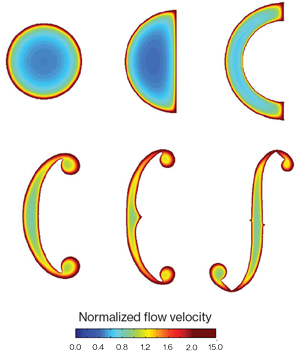Some of the most prized violins in the world were crafted in the Italian workshops of Amati, Stradivari, and Guarneri—master violin-making families from the 17th and 18th centuries, who produced increasingly powerful instruments. These violins, worth millions of dollars today, represent the Cremonese period, considered the golden age of violin making.

Now MIT researchers and violin makers at Boston’s North Bennet Street School have analyzed measurements from hundreds of Cremonese-era violins, identifying features that contribute to their acoustic power, or fullness of sound.
The researchers acquired technical drawings of violins from museums, collector databases, and books, as well as x-rays and CT scans of the instruments. They compared the dimensions of various features and measurements of acoustic resonances in different instruments.
The researchers found that a key feature affecting a violin’s sound is the shape and length of its “f-holes,” the f-shaped openings through which air escapes: the more elongated these are, the more sound a violin can produce. An elongated sound hole takes up little space on the violin, while still producing a full sound—a more power-efficient design than the rounder sound holes of the violin’s ancestors, such as medieval fiddles and lyres.
The violin’s back plate also contributes to its acoustic power. Violins carved from wood are relatively elastic: as the instrument produces sound, its body responds to the air vibrations. A thicker back plate leads to more sound power at the air resonance frequency.
As violins were crafted first by Amati, then by Stradivari, and finally by Guarneri, they evolved to have longer f-holes and thicker back plates.
But were the design changes intentional? To answer this question, the researchers worked the measurements from hundreds of Cremonese-era violins into an evolutionary model. They found that any change in design could be explained by natural mutation—in this case, craftsman error.
“If you try to replicate a sound hole exactly from the last one you made, you’ll always have a little error,” says Nicholas Makris, a professor of mechanical and ocean engineering at MIT. “You’re cutting with a knife into thin wood and you can’t get it perfectly, and the error we report is about 2 percent … always within what would have happened … accidentally from random fluctuations.”
Makris stresses that while all the violin makers inarguably possessed good ears, whether they recognized the particular design elements that contribute to a more powerful sound is still up for debate.
“Mystery is good, and there’s magic in violin making,” he says. “But here, for us, it’s good to understand scientifically as much as you can.”
Keep Reading
Most Popular
Large language models can do jaw-dropping things. But nobody knows exactly why.
And that's a problem. Figuring it out is one of the biggest scientific puzzles of our time and a crucial step towards controlling more powerful future models.
How scientists traced a mysterious covid case back to six toilets
When wastewater surveillance turns into a hunt for a single infected individual, the ethics get tricky.
The problem with plug-in hybrids? Their drivers.
Plug-in hybrids are often sold as a transition to EVs, but new data from Europe shows we’re still underestimating the emissions they produce.
Google DeepMind’s new generative model makes Super Mario–like games from scratch
Genie learns how to control games by watching hours and hours of video. It could help train next-gen robots too.
Stay connected
Get the latest updates from
MIT Technology Review
Discover special offers, top stories, upcoming events, and more.